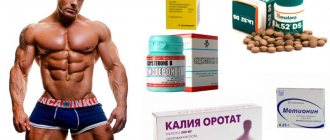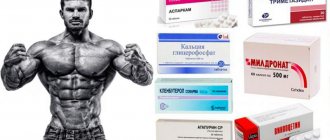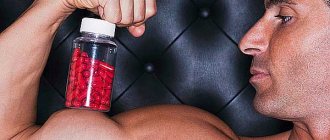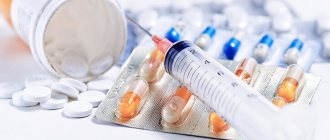Steroid hormones are widely used in many areas of medical practice. Like other hormonal drugs, they are surrounded by many myths and prejudices. Let's take a closer look at them. The first steroid hormones were isolated in 1935 and used for the first time in 1949 in patients with rheumatoid arthritis. Steroid hormones are synthesized by the adrenal cortex and gonads. They are lipophilic and pass through the lipid bilayer of the cell membrane, interacting with cytoplasmic receptors. Among the steroid hormones synthesized by the human body are:
- Mineralocorticoids
- Glucocorticoids
- Sex hormones
At the same time, synthetic steroid hormones – anabolic steroids – have become widely used.
Liver damage.
There is evidence of adverse effects of steroids on the liver, especially when taken orally.
Most studies were conducted on patients suffering from diseases such as anemia, kidney failure, impotence and pituitary dysfunction. Various forms of cancer tumors - benign (adenoma) and malignant (hepatocellular carcinoma) also cannot be ignored. There is also evidence that liver tumors are caused by anabolic steroids containing a 17-alpha alkyl group. Benign tumors usually resolve after stopping steroids. However, there are indications that steroid use by athletes can lead to hepatic carcinoma. Often such changes go unnoticed, since hepatitis and tumors in the liver do not always cause changes in the blood, which is usually used to judge the condition of this organ.
The use of anabolic steroids causes an increase in the activity of liver enzymes in the blood. They are present in hepatocytes (liver cells) in relatively high concentrations, and an increase in their plasma levels indicates liver damage or at least an increase in the permeability of hepatocellular membranes. However, the results of studies on the effect of steroids on the liver are very contradictory. In some cases the enzyme levels increased and in others they did not.
Moreover, this increase was insignificant and quickly disappeared when the drug was stopped. There are suggestions that the reaction of liver enzymes to taking steroids is determined by the state of the organ itself before this. Therefore, people with liver problems are at greater risk when using steroids.
Toad poisons and sea onion aglycones
(Scilla maritima
). Toad poisons are secreted by skin glands. They are used in medicine. They have the same effect on the mammalian heart as cardiac glycosides due to the steroidal bufogenins present in them. Related compounds are also present (in the form of glycosides) in sea onions, which have been used since ancient times as medicine (Ancient Egypt, Ancient Rome). The most important of the bufogenins, bufalin and bufotalin, were isolated from the skin of the Chinese toad. Scillarene A has been isolated from sea onion glycosides, the saponification of which produces the aglycone scillaridine A.
The effect of steroids on the male reproductive system
The use of steroids leads to high physiological concentrations of testosterone or its derivatives. The synthesis and release of luteinizing hormone and follicle-stimulating hormone are reduced. Long-term use of high doses of anabolic steroids leads to hypogonadotropic hypogonadism with reduced concentrations of luteinizing and follicle-stimulating hormones, as well as testosterone in plasma.
The duration of use, dosage and chemical structure of steroids affect the plasma concentration of gonadotropins. And its slight decrease causes a decrease in sperm production and testicular atrophy. In athletes taking steroids, the number of degenerative sperm increases, which reduces the ability to fertilize. It may take several months for these functions to return after stopping the drug. A well-studied side effect of steroids is the development of female-pattern breasts (gynecomastia).
This is a common side effect of steroid use, and you can always tell who is using or has used steroids by its presence without drug testing. Bill Phillips claims that at least nine Mr. Olympia contestants in recent years have undergone surgery to remove fatty tissue that has accumulated around their nipples. This occurs due to increased circulation of the female sex hormone estrogen in the body. Estrogens estradiol and estrone are formed in men by peripheral aromatization from anabolic steroids. Elevated levels of available estrogen stimulate the proliferation of breast tissue. Breast changes are usually irreversible. Sometimes this is even accompanied by milk secretion!
Some experts associate increased estrogen levels in the body of men who use steroids with risk factors for cardiovascular disease.
Steroids can affect your sex drive. Although several experiments have shown an increase in sexual desire, cases of erectile dysfunction are becoming more frequent. There is a contradiction here, but it is easy to explain. Sexual desire depends on androgens, but erection does not. Due to an increase in aggressiveness along with an increase in sexual desire, an athlete taking a steroid may commit a sexual crime.
Cardiac glycosides
– very toxic substances of plant origin, but in small doses they stimulate cardiac activity. Used to treat heart and other diseases. Under the influence of acids, they break down into sugars and aglycone (steroid). Free aglycones of cardiac glycosides (genins) are strong poisons that are not used in medicine; Among them, strophanthidin (convallate oxygenin) is the most well studied; it is contained in lily of the valley, hemp lily, and wallflower. Other aglycones are also known, for example, digitoxigenin, dioxygenin, gitoxigenin, periplogenin, sarmentogenin, adonitoxigenin, etc. see also
GLYCOSIDES.
The effect of steroids on the female reproductive system
The normal female body produces a small amount of testosterone and, as in men, artificially increasing its level using anabolic steroids affects the hypothalamus-pituitary-gonad system. An increase in the amount of androgens in the body suppresses the production and release of other hormones (estrogens and progesterone, as well as others), which leads to slower follicle formation, ovulation and menstrual irregularities.
Another effect of steroids is increased libido and clitoral hypertrophy. Such conclusions were made based on studies of patients undergoing treatment with anabolic steroids.
Some other side effects are acne, baldness, raised hairline, male-pattern bald spots, deepening of the voice, increased facial hair growth, and breast atrophy. Moreover, a decrease in the timbre of the voice, a decrease in breast size, hypertrophy of the clitoris and hair loss are irreversible changes.
Glucocorticoids
In the human body they are produced by the zona fasciculata of the adrenal cortex. Regulation of glucocorticoid production is provided by ACTH, synthesized in the pituitary gland. Hormone production occurs cyclically. Thus, the greatest number of them is recorded in the morning and in the first half of the day, then gradually decreasing. Their level also increases during injuries, stressful situations, and states of shock. The main glucocorticoid hormone in humans is cortisol.
An increased level of cortisol indicates the following disorders in a person’s physical and mental state:
- Stressful state (work overload or personal emotional distress)
- Prolonged depression
- Benign tumor diseases of the adrenal glands (adrenal adenomas)
- Adrenal cancer
- Pituitary adenoma
- Hypoglycemia
- Hyperplastic processes in the adrenal glands
- One form of polycystic ovary syndrome
- Thyroid diseases (hypothyroidism)
- Obesity
- Diabetes mellitus in the stage of decompensation
- Taking synthetic corticosteroids
Low cortisol levels may indicate:
- Hepatitis
- Toxicosis of pregnant women
- Cirrhosis of the liver
- Hypofunction of the adrenal cortex
- Addison's disease
- Cachexia (depletion of the body)
Classification of glucocorticoid hormone preparations:
- Preparations of natural hormones and their esters (cortisone, hydrocortisone)
- Synthetic drugs Inhalation (triamcinolone, beclomazone, budesonide, fluticasone)
- Systemic (prednisolone, methylprednisolone, betamethasone, dexamethosone, triamcinolone)
- Local action (flumethasone pivalate, budesonide, betamethasone)
According to the fluorine content, the following are distinguished:
- Fluoride-free (cortisone, hydrocortisone, prednisolone, methylprednisolone)
- Fluorine-containing (have mineralocorticoid activity)
Biological effects:
- Carbohydrate metabolism – stimulate gluconeogenesis, increase the concentration of glucose in the blood, reduce glucose consumption by cells
- Protein metabolism - slow down the synthesis and increase the breakdown of proteins, provide gluconeogenesis due to amino acids
- Fat metabolism - slow down lipolysis, cause redistribution of adipose tissue
- Water-salt metabolism - retention of Na and H2O, loss of K, Ca, Mg, loss of Ca in bones, impaired absorption of Ca in the intestine.
Pharmacological effects:
- Anti-inflammatory - inhibit the activity of phospholipase A2, reduce the synthesis of prostaglandins and leukotrienes. Reduce permeability and increase resistance of cell membranes. Retards the development of connective tissue. They reduce the number of leukocytes in the area of inflammation, suppress the activity of macrophages and fibroblasts, and reduce the release of inflammatory mediators. Increases the activity of histaminase and cholinesterase.
- Immunosuppressive – suppress the activity of T and B lymphocytes, reduce the synthesis of antibodies and interleukins.
- Anti-shock – enhance the effect of vasopressors and heart function. Promote an increase in blood volume and reduce the synthesis of fatty acids.
Indications:
- Inflammatory infectious-allergic diseases
- Severe infectious diseases
- Severe allergic conditions
- Traumatic shock
- Leukemia, lymphogranulomatosis
- Organ and tissue transplantation
- Acute pancreatitis
- Replacement therapy for adrenal insufficiency
Side effects:
- Withdrawal syndrome
- Acute adrenal insufficiency
- "Steroid diabetes"
- Osteoporosis
- Itsenko-Cushing's symptom
- Exacerbation of peptic ulcer
- Increased risk of developing infectious diseases
- Slowing down regeneration processes
- Menstrual irregularities
- Impotence
- Insomnia, psychosis, convulsions, euphoria
- Glaucoma
- Increased blood clotting
Since glucocorticoids are essentially a “double-edged sword”, representing drugs that are irreplaceable in terms of therapeutic effects, and causing severe side effects, a method was developed to monitor the occurrence of side effects of glucocorticoid therapy:
- 1. Monitoring the dynamics of body weight.
- 2. Blood pressure control.
- 3. Study of blood sugar and urine.
- 4. Monitoring the electrolyte composition of plasma. To prevent hypokalemia, the risk of which increases with the concomitant use of diuretics, potassium supplements are prescribed.
- 5. Monitoring the condition of the gastrointestinal tract. In patients with dyspeptic symptoms, antacids are prescribed to prevent ulcer formation, but their protective effect has not been firmly proven.
- 6. Monitoring the condition of the musculoskeletal system. Long-term use of glucocorticoids at a dose of >7.5 mg/day for prednisolone leads to the development of osteoporosis of long bones.
- 7. Ophthalmological examination. Measurement of intraocular pressure and slit lamp examination to detect cataracts.
- 8. Monitoring the development of infectious complications.
- Pregnancy
- Lactation
- Itsenko-Cushing's disease
- Nephrosis, nephritis
- Osteoporosis
- Peptic ulcer of the stomach and duodenum
- Diabetes
- Active form of tuberculosis
- Glaucoma
- Severe forms of hypertension
Contraindications:
The therapeutic and toxic effects of glucocorticoids are reduced by inducers of microsomal liver enzymes, and enhanced by estrogens and oral contraceptives. Digitalis glycosides, diuretics (causing potassium deficiency), amphotericin B, carbonic anhydrase inhibitors increase the likelihood of arrhythmias and hypokalemia. Alcohol and NSAIDs increase the risk of erosive and ulcerative lesions or bleeding in the gastrointestinal tract. Immunosuppressants increase the likelihood of developing infections. Glucocorticoids weaken the hypoglycemic activity of antidiabetic agents and insulin, the natriuretic and diuretic activity of diuretics, the anticoagulant and fibrinolytic activity of coumarin and indanedione derivatives, heparin, streptokinase and urokinase, the activity of vaccines (due to a decrease in the production of antibodies), and reduce the concentration of salicylates and mexiletine in the blood. Erythromycin increases the activity of glucocorticoids (slows down their metabolism in the liver), salicylates (increase the fraction of glucocorticoids not bound to proteins), and estrogens. When using prednisolone and paracetamol, the risk of hepatotoxicity increases. Increased activity is also observed in acute liver diseases, hypothyroidism, hypoalbuminemia, and increased levels of endogenous estrogens. Activity decreases with hypothyroidism. In critical care medicine, pulse therapy and intravenous administration of ultra-high doses of glucocorticoid hormones are widely used. Indications are septic shock, status asthmaticus, acute myocardial infarction with the development of Dressler's syndrome, Quincke's edema, cerebral edema, Lyell's syndrome, multiple sclerosis, etc. The use of pulse therapy for the prevention and relief of a transplant rejection crisis is considered standard. The rationale for this type of therapy is the ability of glucocorticoids to suppress the activity of the immune system. The effect is to suppress the activity of neutrophils and monocytes, which leads to transient redistributive lymphopenia. In addition, when B cells are exposed to hormones, immunoglobulin production decreases, followed by a decrease in the number of circulating immune complexes and autoantibodies.
The effect of steroids on blood lipoproteins and the heart
Most studies of the effects of anabolic steroids in humans have focused on the risk factor for cardiovascular disease and especially their effects on blood pressure and plasma lipoproteins. In most studies, plasma cholesterol and triglyceride levels were not significantly different between steroid users and avoiders. However, during a course of steroid use, total cholesterol levels tend to increase, while high-density lipoprotein (“good” cholesterol) drops below normal levels. Low-density lipoprotein (cholesterol) levels fluctuate slightly, rising slightly or remaining the same. An experiment was conducted where ten strength athletes taking steroids were compared with their sports colleagues who did not use steroids. The control group included ten men who did not engage in sports at all. Using electrocardiograms and ultrasound video equipment to measure density, the scientists found that the athletes who used steroids had significantly higher diastolic pressure and greater left ventricular hypertrophy than subjects in the other two groups. This gave reason to conclude that steroids negatively affect the heart muscle and heart function.
There is other evidence that steroids cause structural changes in the heart and reduce ischemic tolerance. An echocardiographic examination of bodybuilders taking anabolic steroids revealed slight hypertrophy of the left ventricle of the heart. Some scientists associate cases of cardiomyopathy, myocardial infarction and other cerebrovascular diseases with steroid use. There is compelling evidence that injected steroids are safer than oral steroids.
Content
- 1 Side effects of steroids 1.1 General measures to prevent harm
- 1.2 Contraindications to taking steroids
- 2.1 Suppression of the production of own testosterone
Hypertension (high blood pressure)
High or at least elevated blood pressure becomes a problem for many athletes who use steroids. This usually occurs simultaneously due to both water retention in the body and a rapid increase in body weight. Initial symptoms of increased blood pressure may include headaches, insomnia, and difficulty breathing. This condition is also fraught with gradual degeneration of blood vessels, which leads to aneurysms, heart attacks and even progressive heart disease. It should be remembered that blood pressure exceeding 130/90 or more is a signal to take measures to regulate your condition. First of all, this is weight loss, reducing salt intake, and aerobic exercise. There is no need to convince you once again that chronic high blood pressure is the cause of many diseases of the cardiovascular system, which kill the most people on the planet.
Recommendations
The safety of a certain number of drugs is maintained only if the dosage is observed. When an athlete exceeds the specified norm or takes them uncontrollably, health problems come along with the positive effect.
If an athlete chooses a steroid drug to gain greater endurance, strength, beautiful definition or impressive muscles, he must clearly understand all the possible consequences of such a choice. To maintain the body while taking steroids, you will need supplements, recovery courses, neutralizers, and even more and more chemicals.
Safe steroid cycle
A course of steroids is considered safe when its negative effect on the athlete’s body is minimal. At the same time, the athlete follows clear rules for the dosage of drugs, the duration of the course and compatibility with each other.
When taking steroids, it is important to follow these guidelines:
- contact experienced athletes and coaches;
- do the course for no more than 16 weeks;
- choose drugs that minimally affect the production of your own testosterone;
- the use of post-cycle therapy (PCT) drugs, which neutralize harm to the body, suppress female hormones, and reduce rebound;
- do not apply before reaching 25 years of age;
- monitor blood biochemistry indicators by taking tests;
- combine the use of anabolic steroids with vitamins and supportive therapy for the liver;
- do not use drugs for women and persons with diseases of the heart, blood vessels, liver, kidneys, high blood pressure, or with a predisposition to oncology;
- Inject with sterile hands.
There are no completely harmless anabolic steroids. When choosing drugs, you should always focus on the minimum amount of harmful effects. It is necessary to avoid products with toxic effects, leaving only the best ones - those that give the desired effect, but do not harm health.
In order to reduce the negative effects of anabolic steroids and increase their effectiveness, it is recommended to use 2-3 drugs simultaneously. This allows you to achieve a synergistic effect between them (increase each other’s therapeutic effect) and reduce dosages.
The most popular combinations:
- Testosterone enanthate (500 mg) and retabolil (200 mg). Injections once a week intramuscularly into the buttock. Course - 2 months. Great for beginners.
- Boldenone (400 mg per week), testosterone propionate (100 mg every other day). Some of the safest drugs. Suitable for beginners and seniors. Course - 6-8 weeks.
- Strombafort (40 mg per day) and testosterone enanthate (500 mg per week). Allows you to quickly increase quality mass with minimal risks. The duration of the course is 8 weeks.
Despite the appearance of safe drugs, we must not forget that strength, health and beauty at the same time can only be found in natural sports. Do not forget to consult with specialists before taking any medications.
Diseases of the cardiovascular system
Anabolic steroids are a significant risk factor for heart disease. This is largely due to the fact that steroid use negatively impacts the user's cholesterol levels and profile: total cholesterol levels increase, high-density lipoprotein (HDL) levels decrease, and low-density lipoprotein (LDL) levels increase. This can lead to the formation of cholesterol plaques on the walls of the arteries, and later to complete blockage of the vessels. To avoid this condition, experts advise using blood test data as a starting point for deciding whether to take steroids, especially if your cholesterol levels are elevated before starting steroid therapy.
The risk of anabolic steroid use is variable and depends on the types of steroids, doses, duration and patterns of use, diet composition, genetic sensitivity to cardiovascular disease, amount and type of exercise, and the presence or absence of other risk factors.
Psychological effects of steroid use
Steroids affect human behavior. An increase in the amount of testosterone leads to a more “masculine” type of behavior, increased aggressiveness and increased sexual desire. This is beneficial in training, but can be dangerous outside the gym or track. There are known cases of aggressive, sometimes even criminal, behavior of people who took steroids. Other side effects include euphoria, excitability, sleep disturbance, restlessness, paranoia and hallucinations.
Increased aggression is very common in steroid users. Some athletes feel that this helps them endure training loads more easily and perform better in competitions. However, more often aggression becomes a negative phenomenon. Many steroid users find that they are hostile towards family, friends, co-workers; their behavior becomes defiant and intolerable. Ordinary situations that, without departing from a number of life situations, develop in training halls or outside them, can cause an aggressive reaction in such a person, which becomes even more pronounced when using alcohol. Highly androgenic steroids lead to this type of behavior. In addition, the athlete must anticipate such developments and prepare to suppress unwanted outbursts of rage through willpower.
Two psychiatrists from Harvard Medical School, Dr. Harrison Pope and David L. Katz, discovered serious mental disorders in individuals using anabolic steroids: depressive episodes, visual and auditory hallucinations. Some steroid users have experienced uncontrollable outbursts of irritability and manic episodes. In the West, some psychiatrists and psychologists are already widely using the term “steroid rage” due to the fact that manifestations of this side effect are becoming more frequent and recorded.
The classic effect of steroid use is emotional instability. Dr. Kitzman believes that steroid users develop a certain type of psychological dependence on them.
Examining teenagers, psychologists found that those who are on steroids are three times more likely to engage in antisocial activities. They sleep with anyone - naturally, without condoms. And as a result: a bouquet of “interesting” diseases.
A psychopathically thoughtless attitude towards their own and other people’s lives manifests itself at every step: if they get behind the wheel of a motorcycle, they always do so without a helmet and while drunk; they carry various home-made weapons with them and get involved in fights, often without any reason.
Drug addiction among young “jocks” is generally a special issue. Drugs and steroids walk hand in hand, like twin brothers. One dangerous habit inevitably leads to another. Anyone who has dabbled in “weed” without hesitation begins to inject himself with steroids. Conversely, steroid fans often become heavy drug addicts. In the United States, more and more steroid users are being jailed due to their violent behavior, attacks on people and even murders. There are reports that lawyers in some US states are bringing in steroid experts to make sure that their clients' behavior is a consequence of steroid use. Delusions of grandeur and paranoia are also very common signs of this side effect of steroids, and you could probably see this for yourself.
Anabolic steroid.
The term “anabolic” reflects the ability of these substances to enhance protein synthesis in various organs and tissues, maintain a positive nitrogen balance and cause weight gain. These drugs came to the USSR in the 60s of the last century. To increase strength indicators at that time, athletes literally ate them for breakfast; steroids were considered something like vitamins. But after the Montreal Olympics (1976), they were recognized as doping and banned in professional sports. Often these drugs are perceived only as means used to improve athletic performance, so, according to various sources, from 70 to 90% of professional bodybuilders have used them at least once in their lives. They are synthesized on the basis of male sex hormones and have an anabolic effect (stimulate the synthesis, the process of renewal of the structural elements of cells and tissues).
Anabolic steroids affect protein metabolism, phosphorus-calcium metabolism, synthesis of intracellular enzymes, hormonal balance, etc. As a result of their action, anabolic processes in the body predominate over catabolic ones. Let's take a closer look at their effect on the body.
The effect of anabolic steroids on protein metabolism lies in their effect on the genetic apparatus of the cell. They block the gene depressor of protein synthesis, enhancing the synthesis of both structural proteins and RNA and DNA. The permeability of cell membranes for amino acids, trace elements and carbohydrates increases. A positive nitrogen balance is established.
At the same time, they promote calcium fixation in bones and increase bone mass in osteoporosis. By increasing cell proliferation and increasing the activity of alkaline phosphatase produced by osteoblasts. Anabolic steroids stimulate the synthesis of intracellular enzymes, especially cytochromes, due to which the processes of tissue respiration and oxidative phosphorylation, the formation of ATP and creatine phosphate, necessary for many biochemical processes, are enhanced. They increase the rate of glycogen synthesis, enhance the action of insulin, potentiate the action of endogenous somatotropin, activate reparative processes in the integumentary and glandular epithelium, stimulate the production of erythropoietin, increase the absorption of amino acids in the small intestine, increase appetite, the concentration of plasma albumin, and promote weight gain.
Indications:
- Cachexia
- disturbance of protein metabolism (after severe injuries, surgeries, burns, radiation therapy)
- severe infectious diseases accompanied by protein loss
- progressive muscular dystrophy, glucocorticoid-induced myopathy
- diabetic angiopathy
- the need to accelerate regeneration in fractures and injuries
- growth retardation in children (Shereshevsky-Turner syndrome, pituitary dwarfism)
- delayed puberty (pubertal infantilism) and physical development in boys
- encephalopathy due to alcoholic hepatitis
- anemia in chronic renal failure, myelofibrosis, myelosclerosis, myeloid aplasia of the bone marrow (refractory to conventional therapy),
- damage to the bone marrow by metastases of malignant neoplasms, myelotoxic drugs and salts of heavy metals
Contraindications:
- Hypersensitivity
- prostate cancer
- malignant breast tumors in men
- breast carcinoma in women with hypercalcemia (can activate osteoclasts and cause bone resorption)
- pregnancy (has embryotoxicity, fetotoxicity, can cause muscularization of the female fetus)
- acute and chronic liver diseases
- nephritis
- nephrotic syndrome
- lactation
- hypercalcemia
Carefully:
- chronic heart failure
- coronary atherosclerosis
- myocardial infarction (including history)
- diabetes
- elderly age
- childhood and adolescence (risk of premature closure of epiphyseal growth plates, early puberty in boys and virilization in girls)
Side effects:
Gastrointestinal tract:
- dyspeptic symptoms (nausea, vomiting, diarrhea, abdominal pain),
- liver dysfunction,
- jaundice.
SSS:
- hypocoagulable state with tendency to bleed
- leukemoid syndrome (leukemia, pain in long bones)
- Iron-deficiency anemia
- Other: progression of atherosclerosis (increased LDL concentration and decreased HDL concentration)
- peripheral edema.
With long-term use/overdose:
- hepatonecrosis (dark stool, vomiting with blood, headache, discomfort, breathing problems)
- hepatocellular carcinoma
- hepatic purpura (dark urine, discoloration of stool, urticaria, pinpoint or macular hemorrhagic rashes on the skin and mucous membranes, pharyngitis or sore throat)
- cholestatic hepatitis (yellow discoloration of the sclera and skin, pain in the right hypochondrium, dark urine, discolored feces)
- increased secretion of sebaceous glands
- chills
- increase or decrease libido
- diarrhea
- feeling of fullness in the stomach
- flatulence
- convulsions
- sleep disturbance.
- In women: virilization (enlargement of the clitoris, deepening or hoarseness of the voice, dys- and amenorrhea, hirsutism, steroid acne, oily skin), hypercalcemia (central nervous system depression, nausea, vomiting, increased fatigue).
- In men: in the prepubertal period - manifestations of excessive androgenic activity (acne, penis enlargement, priapism, formation of secondary sexual characteristics), idiopathic hyperpigmentation of the skin, slowing or cessation of growth (calcification of the epiphyseal growth zones of tubular bones). In the postpubertal period - irritation of the bladder (increased frequency of urges), mastodynia, gynecomastia, priapism, decreased sexual function; elderly – prostate hyperplasia and/or carcinoma.
Interaction:
- Glucocorticoids, mineralocorticoids, corticotropin, sodium-containing drugs and foods rich in sodium potentiate (mutually) fluid retention in the body, increase the risk of developing edema, and increase the severity of acne.
- Enhance the effects of antiplatelet agents, indirect anticoagulants, insulin and oral antidiabetic agents (inhibits their biotransformation)
- They weaken -GH and its derivatives (accelerates the mineralization of the epiphyseal growth zones of tubular bones).
- enhance the effect of anticoagulants, antiplatelet agents and hypoglycemic agents, as well as the side effects of hepatotoxic drugs.
It should be remembered that taking anabolic steroids leads to a sharp increase in protein absorption by the body. In this regard, during therapy, the proportion of protein in the diet must be increased, and fats and carbohydrates must be reduced. Currently, claims that anabolic steroids have a negative effect on male sexual function can be considered unfounded. In therapeutic dosages, they cause increased sexual desire with a simultaneous improvement in the morphological state of the gonads. However, with uncontrolled use of anabolic steroids by amateur athletes, severe side effects may occur. The male sex hormone testosterone is mainly responsible for them; all anabolic steroids contain them to one degree or another. One of these effects is the so-called “steroid rage”. Its mechanism is based on the ability of testosterone to regulate sexual behavior by acting on testosterone receptors in the brain. This is characterized by manifestations of aggression and rage. But with prolonged abuse of anabolic steroids, aggression may be replaced by manic-depressive psychosis. At the same time, long-term overdose can cause disruption of the synthesis of endogenous testosterone by Leydig cells. In this case, at first there is an increase in libido, but then oligospermia, impotence and hypogonadism take over. It is also possible to develop osteoporosis. The anabolic activity of a drug is assessed in comparison with the anabolic activity of testosterone, taken as a unit. Androgenic activity is determined in a similar way. The ratio of anabolic to androgenic activity is called the anabolic index. The most valuable therapeutically is the drug that has the highest anabolic index as an indicator of the predominance of anabolic activity over androgenic activity. Thus, the drug methandrostenolone, in comparison with testosterone, has equal anabolic and 100 times reduced androgenic activity. Phenobolin in relation to testosterone – high anabolic and low androgenic activity. It usually does not cause virilization. Retabolil has high anabolic activity, prolonged action (3-4 weeks), its androgenic activity is weaker than phenobolin. Sinabolin has high anabolic activity, prolonged action (10-14 days), androgenic activity is weak. Methylandrostenediol has greater anabolic activity than testosterone, and greater androgenic activity than other anabolics.
Sodium retention
This is the most common side effect. It causes edema (tissue swelling due to excess water retention). For most athletes, this is expressed in a slight increase in body volume and smoothing of the relief. This swollen appearance is the most noticeable sign by which you can determine, even without doping control, that an athlete is on a cycle. This is especially noticeable on the cheeks and under the eyes. In addition to this cosmetic inconvenience, sodium and water retention, as a result, can lead to acute attacks of high blood pressure. Sometimes such water retention is a sign of hidden heart or kidney disease. Particularly severe water retention can be caused by various testosterone preparations.
Acne (blackheads)
This is also a very common side effect of steroid use. Anabolic steroids can cause acne or make existing acne worse. Human skin has the ability to destroy androgenic hormones, which are found in it in very small quantities. When exogenous steroids are used, the concentration tends to increase beyond what the skin can handle, allowing bacteria to multiply. When this is combined with increased oiliness of the skin, which is inevitable with steroid use, the situation becomes even more unfavorable.
There may be a genetic predisposition to acne. The extent of acne damage to the skin depends on the androgenicity of the steroids taken. Severe acne on the back, chest, shoulders, neck and face is a sign that some athletes are on a cycle.
Steroids are banned in Ukraine and Russia
The legal status of anabolic steroids is determined by the legislation of both countries.
Ukraine: The Criminal Code of Ukraine imposes penalties related to the substance under Article 321 on the illegal manufacture, storage, transportation and distribution of poisonous or potent drugs.
Russia: some anabolic drugs are included in the list of potent and toxic substances for the purposes of Article 234 and other articles of the Criminal Code of the Russian Federation.
Oncological diseases (Cancer)
The use of anabolic steroids is very rarely associated with cancer. The result of taking steroids is tumors in the liver, suspected of cancer. It must be said that in most cases these deviations were recorded in people who had been using alpha-alkylated oral medications for a long time. It is known that the liver and kidneys are subject to severe stress when using steroids. No less rare is “peliosis hepatitis,” that is, blood-filled cysts in the liver. This condition is reversible, meaning they disappear when steroid use is stopped, but it is nevertheless associated with the development of liver cancer. It has also been established that long-term steroid therapy, especially at high dosages, leads to progressive cholestasis, jaundice and other negative changes.
How to take and features of use?
Tablet preparations are taken 10 minutes after meals or before taking a sports supplement. Taken before meals is associated with powerful absorption of nutrients for muscle growth. A course of tablet drugs is taken as a “ladder” or a pyramid (gradually increasing the daily dosage) or as a background, when the dosage does not change throughout the entire intake.
It is important to know the time of elimination of a particular drug from the body, so that the hormonal background created by synthetic hormones does not have any “holes”, that is, it has an even effect. For example, the effect of methandienone does not exceed 6 hours and with a one-time dose the effect on the body completely disappears, while a drug such as stanozolol acts for nine hours.
The use of injectable drugs must be taken seriously.
Firstly, oil injections take a long time to dissolve, and if administered incorrectly, they can lead to an abscess. Injections can only be done intramuscularly. The gluteal muscles, deltoids and quadriceps are great for injections.
Secondly, it is important to insert the needle to its full length and use needles from 5 cc syringes, for ease of administration of the drug; needles from 2 cc are too thin and are completely unsuitable for some esters.
Thirdly, the ampoule needs to be warmed up before administration, this will make the oil more liquid. Unlike oral medications, for which a daily dosage is calculated, injectable medications are calculated for a week or ten days. For example: the weekly dose of testosterone enanthate is 500 mg, which means that this dose is divided into two injections, with an equal period of time between them. Or every five days or every day of the week (Monday, Thursday).
Steroid smile
It’s easy to recognize someone who takes steroids for a long time... by their teeth. More than 70% of bodybuilders who give themselves steroid injections suffer from a special disease - jaw muscle spasms. In the morning, they wake up with their jaws clenched tightly, and the compression is so strong that it changes the position of the teeth and damages the enamel. At night, the relatives of such bodybuilders are disturbed by the “creaking” of their teeth, which is also a consequence of jaw spasm. However, this is not the only dental-related consequence of taking steroids. Doctors name at least 5 more pathological symptoms: Wear of the ligaments of the jaw attachment due to spasmodic contraction of the jaw muscles.
Weakening of the salivary glands, leading to a deficiency of saliva (dry mouth). After tooth extraction, suppuration often occurs. Removal is associated with complications due to thickening and hardening of the jaw bone. Resistance to dental and oral infections is reduced.
Anesthesia during dental treatment often gives a picture of shock due to the reaction of painkillers to the changed composition of the blood. In conclusion, it is worth mentioning the serious consequences of taking anabolic steroids in combination with other pharmacological drugs. On the one hand, this is done in an attempt to neutralize their side effects. Growth hormone, thyroid hormones, antiestrogens, and antidepressants are used. On the other hand, people try to maintain the anabolic effect of steroids by taking other anabolic hormones, such as growth hormone, insulin, clenbutyrol or another form of anabolic steroids. All this is carried out without proper medical supervision and can lead to serious illness.
Notes[edit | edit code]
- Journal of Steroid Biochemistry and Molecular Biology. 84 (2003) 369-375)
- Med Sci Sports Exerc. 1999 Feb;31(2):243-50, Rat liver lysosomal and mitochondrial activities are modified by anabolic-androgenic steroids. Molano F, Saborido A, Delgado J, Moran M, Megias A.
- Int J Sports Med 1996 Aug;17(6):429-33, Body composition, cardiovascular risk factors and liver function in long-term androgenic-anabolic steroids using bodybuilders three months after drug withdrawal. Hartgens F, Kuipers H, Wijnen JA, Keizer HA.
- GYNECOMASTIA: ETIOLOGY, DIAGNOSIS, AND TREATMENT Chapter 14 - Ronald S. Swerdloff, MD, Jason Ng, MD, and Gladys E. Palomeno, MD, March 1, 2004
- Am J Clin Dermatol. 2002;3(8):571-8. 2. Clin Dermatol. 2004 Sep-Oct;22(5):419-28. 3. Pol Merkuriusz Lek. 2004 May;16(95):490-2.
- Kanayama G, Kean J, Hudson JI, Pope HG, Jr. (2012): Cognitive deficits in long-term anabolic-androgenic steroid users. Drug and alcohol dependence
- Su TP, Pagliaro M, Schmidt PJ, Pickar D, Wolkowitz O, Rubinow DR (1993): Neuropsychiatric effects of anabolic steroids in male normal volunteers. JAMA: the journal of the American Medical Association. 269:2760-2764
- https://www.biologicalpsychiatryjournal.com/article/S0006-3223(16)32529-X/abstract
- Archives of General Psychiatry, Volume 57, February 2000.
- https://www.sciencedaily.com/releases/2013/05/130520094836.htm
- Human Anatomy and Physiology, 6th Edition, John W. Hole jr., Wm. C. Brown Publishers.
- Fertil Steril. 2004 Jan;81(1):226. 2. Urology. 2000 Oct 1;56(4):669.3. J Clin Endocrinol Metab. 1985 Oct;61(4):746-52 4. Fertil Steril. 1994 May;61(5):911-4. 5. Andrologia. 1985 Sep-Oct;17(5):497-501 6. Urol Clin North Am. 1986 Aug;13(3):455-63.
- https://academic.oup.com/humrep/article-abstract/doi/10.1093/humrep/dex283/4103445/Preconception-urinary-phthalate-concentrations-and?redirectedFrom=fulltext











